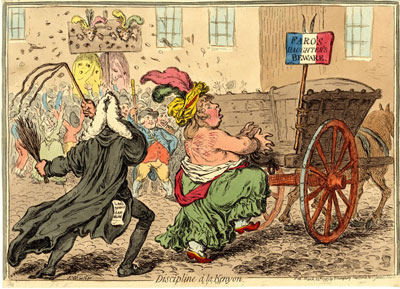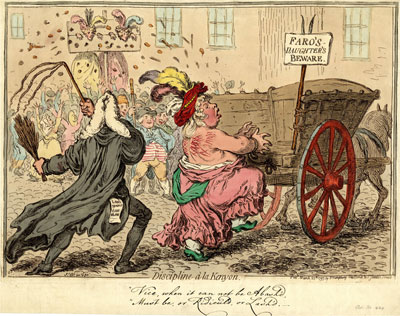Discipline à la Kenyon
This is the fourth and most cruel of the prints by Gillray devoted to Faro's Daughters, a group of women of fashion who held and bankrolled illegal gambling parties at which Faro, a popular card game, was played.

[March 25, 1797]
© Trustees of the British Museum
In the foreground, it depicts the Lord Chief Justice, Lloyd Kenyon, flogging the exposed back of Albinia Hobart, the Countess of Buckinghamshire as she is paraded through the streets behind a horse cart. And in the background, it shows two more of Faro's daughters as they are pelted with refuse while standing in the pillory.
Ironically enough, the print was probably prompted by the theft of the Faro Bank amounting to £500 at Lady Buckinghamshire's house in late January. Gillray had already dealt with the event itself in Loss of the Faro Bank or the Rook's Pigeon'd in February, 1797. But the reported theft of so large a sum led to an investigation which established that at least three women were illegally playing at Faro on the night on January 30th. They were Lady Elizabeth Luttrell, Mrs. Sturt, and Lady Buckinghamshire herself.
Less than a year earlier in May of 1796, Kenyon, the Lord Chief Justice, had "expressed great indignation that. . . gambling had so deeply pervaded the whole mass of the public."
It is extremely to be lamented, [he declared] that this vice has descended to the very lowest orders of the people. It is to be lamented that it is so prevalent among the higher ranks of society, who have set the example to their inferiors, and who, so it seems, are too great for the law. I wish they could be punished. If any prosecutions are fairly brought before me, and the parties are justly convicted, whatever may be their rank or station in the country, though they should be the first Ladies in the land, they shall certainly exhibit themselves in the pillory.
London Star, May 10, 1796,Pg. 4,
Gillray had responded to that declaration immediately with the Exaltation of Faro's Daughters (May 12, 1796) which literally portrayed what Kenyon had only wished if "the parties are justly convicted."
Now a case had been presented and the parties HAD BEEN convicted. But the result fell far short of the bluster of the Chief Justice. A Mr. Martindale was fined £200 as the nominal Keeper of the Faro Table (though clearly established at the lady's house), and Lady Elizabeth Luttrell, Mrs. Sturt, and Lady Buckinghamshire herself were fined a mere £50 each "for playing at the said unlawful game of Faro." If that pat on the wrist were not light enough, the women (through their barristers, of course,) made it known that they intended to appeal the ruling.
All of this would have been known to Gillray. And I can't help but think that the result might have contributed to the saeva indignatio of the print. Here, Gillray seems to say, is the punishmment that should have been meted out to the three women in question if the Chief Justice were true to his word.
There are three slightly different versions of this print. The most frequently produced seems to have been the one shown above where the placard attached to the pitch fork reading "Faro's Daughter's Beware is tinted in tri-colour to resemble a French flag. The colouring would have reminded viewers that, after all, the Faro game originated in France, and with its mix of high and low at the same table, it would have seemed, like French ballet, a Trojan Horse for the introduction of dissolute French values.
The second version is identical to the first but without the tri-colour placard.
The third version omits the tri-colour placard. but includes an additional caption derived from but not identical to, lines in "Verses on the Death of Dr. Swift" which Gillray could have seen in The Works of Jonathan Swift Edited by G. Hamilton, J. Balfour, & L. Hunter, 1757 p. 245, ll. 356-62.

[March 25, 1797]
© Trustees of the British Museum
Swift's original (with a couple of additional lines) is provided below.
Vice, if it e'er can be Abash'd
Must be, or Ridicul'd, or Lash'd.
. . .
Should vice expect to 'scape rebuke,
Because its owner is a duke?
We don't know for sure that the additional caption is by Gillray. It appears to have been engraved separately and attached in the printing process. The style is unusually florid and does not seem to have been well-integrated with the text style in the rest of the print. But we do know that Gillray was extremely well-read, and had a knack for finding the perfect literary allusion to reinforce or enhance the meaning of his prints. It would have been just like Gillray to have found a couplet where he could play with the meaning of lashing as both verbal and physical abuse and in a context of arguing that the upper classes should not escape satire and ridicule.
Sources and Reading
- Commentary from the British Museum on Discipline à la Kenyon.
- Tim Clayton, James Gillray: A Revolution in Satire 2022, p. 249
- Diana Donald, The Age of Caricature, 1996, p. 225 Note 213.
- Draper Hill, Fashionable Contrasts, 1966, #86.
- "Albinia Hobart," Wikipedia
- "Faro Ladies," Wikipedia
- "Lloyd Kenyon, 1st Baron Kenyon," Wikipedia
- Gillian Russell, "Faro's Daughters": Female Gamesters, Politics, and the Discourse of Finance in 1790s Britain," Eighteenth-Century Studies, Vol. 33 No. 4, pp. 481-504.
- Thomas Wright and R.H. Evans, Historical and Descriptive Account of the Caricatures of James Gillray #424.
- Thomas Wright and Joseph Grego, The Works of James Gillray, the Caricaturist; With the History of His Life and Times, pp. 227-8.
Comments & Corrections
NOTE: Comments and/or corrections are always appreciated. To make that easier, I have included a form below that you can use. I promise never to share any of the info provided without your express permission.